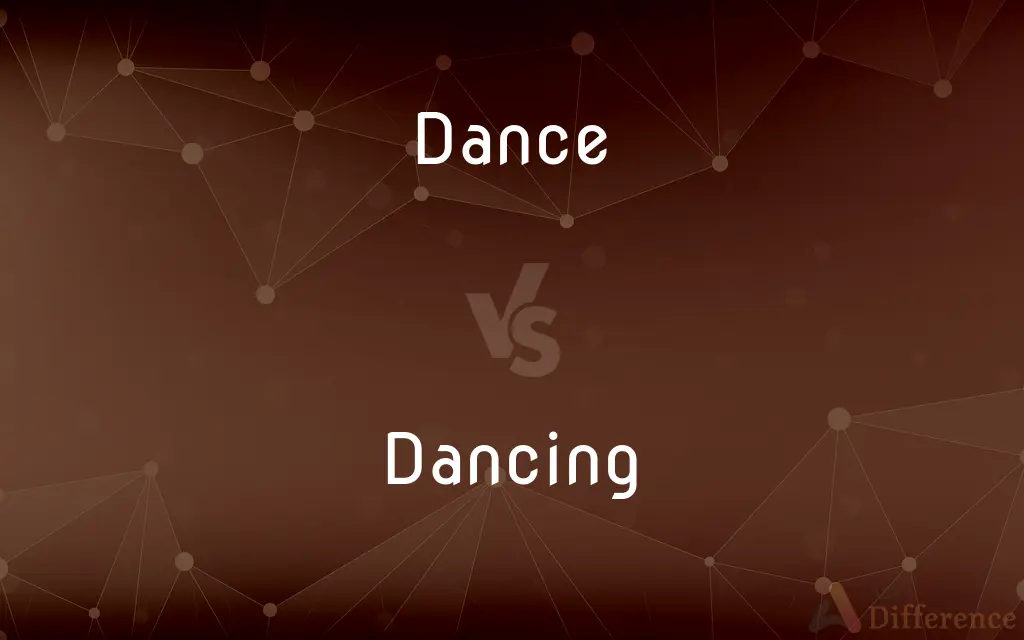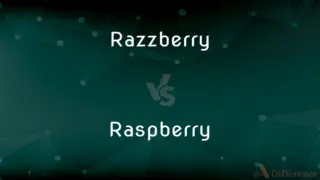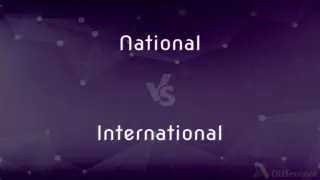Dance vs. Dancing — What's the Difference?
By Tayyaba Rehman — Updated on October 17, 2023
"Dance" is a noun (an art form) or verb (the action), while "dancing" is a gerund or present participle describing the act.

Difference Between Dance and Dancing
Table of Contents
ADVERTISEMENT
Key Differences
"Dance," as a noun, represents an artistic form of movement typically set to music, a structured expression of culture, emotion, or storytelling. As a verb, "dance" describes the action itself, the physical movement often characterized by rhythm and style. "Dancing," in contrast, serves as a gerund or present participle, focusing on the ongoing action or the state of performing dance.
In linguistic terms, "dance" can function as both a noun and a verb, showing its versatility in sentence structure. It can signify an event where people dance, the art form itself, or the action of moving rhythmically to music. "Dancing," however, is a form of the verb "to dance," specifying the action in progress or the general activity of moving rhythmically.
"Dance," when used as a noun, can encapsulate a wide range of styles, from ballet to breakdancing, each with its unique techniques and cultural backgrounds. As a verb, "dance" transcends these styles, becoming a universal descriptor of the action. "Dancing" inherently implies participation and engagement, an active, often communal activity that unites participants in the moment.
In cultural contexts, "dance" can denote a historical or traditional performance significant to certain communities, carrying ancestral stories and societal values. As an action, "dance" is a way individuals express themselves, celebrate, or even protest. "Dancing" emphasizes the process and experience, the joy, effort, and sometimes the shared collective identity found in the movement.
In literary and metaphorical use, "dance" can imply harmony or conflict, as in a "dance of elements" or a "deadly dance," showcasing its broad metaphorical potential. The act of "dancing," however, often suggests joy, freedom, and immersion in the activity, a metaphor for being actively involved or engrossed in a dynamic process or emotional state.
ADVERTISEMENT
Comparison Chart
Grammatical Role
Used as a noun and verb.
Used as a gerund or present participle.
Representation
Refers to the art form or action.
Indicates the action in progress.
Cultural Significance
Can signify specific styles or cultural expressions.
Implies participation, often communal.
Metaphorical Use
Has broad metaphorical potential.
Suggests immersion, activity.
Emotional Connotation
Can vary depending on context.
Generally positive, denotes activity.
Compare with Definitions
Dance
A sequence of rhythmic steps or movements usually performed to music.
They performed a beautiful dance at the ceremony.
Dancing
The activity of participating in a dance.
The night was full of laughter and dancing.
Dance
Dance is a performing art form consisting of sequences of movement, either improvised or purposefully selected. This movement has aesthetic and often symbolic value.
Dancing
The action of moving rhythmically to music.
Dancing brings him an indescribable sense of freedom.
Dance
To move rhythmically usually to music, using prescribed or improvised steps and gestures.
Dancing
Engaging in dance.
She's been dancing since she was four.
Dance
(Zoology) To perform a specialized set of movements to communicate chiefly with other members of the same species.
Dancing
Performing or engaging in a dance or dance-related activity.
Who is dancing the tango in the competition tonight?
Dance
To move or leap about excitedly.
Dancing
To move rhythmically usually to music, using prescribed or improvised steps and gestures.
Dance
To bob up and down or move about rapidly
The leaves danced in the wind.
Dancing
(Zoology) To perform a specialized set of movements to communicate chiefly with other members of the same species.
Dance
To appear to flash or twinkle
Eyes that danced with merriment.
Dancing
To move or leap about excitedly.
Dance
(Informal) To speak or behave in an evasive or vacillating manner
Danced around the issue.
Dancing
To bob up and down or move about rapidly
The leaves danced in the wind.
Dance
To engage in or perform (a dance).
Dancing
To appear to flash or twinkle
Eyes that danced with merriment.
Dance
To lead (someone) in a dance.
Dancing
(Informal) To speak or behave in an evasive or vacillating manner
Danced around the issue.
Dance
To cause to move up and down quickly or lightly
Danced the child on her knee.
Dancing
To engage in or perform (a dance).
Dance
A series of motions and steps, such as the waltz or tango, usually performed to music.
Dancing
To lead (someone) in a dance.
Dance
The act or an instance of dancing
May I have this dance?.
Dancing
To cause to move up and down quickly or lightly
Danced the child on her knee.
Dance
The music composed or played for a certain kind of dance or for a particular dance.
Dancing
A series of motions and steps, such as the waltz or tango, usually performed to music.
Dance
The art of dancing
Studied dance in college.
Dancing
The act or an instance of dancing
May I have this dance?.
Dance
A party or gathering of people for dancing.
Dancing
The music composed or played for a certain kind of dance or for a particular dance.
Dance
(Zoology) An act of communication by dancing
A peacock's courtship dance.
Dancing
The art of dancing
Studied dance in college.
Dance
A sequence of rhythmic steps or movements usually performed to music, for pleasure or as a form of social interaction.
Dancing
A party or gathering of people for dancing.
Dance
A social gathering where dancing is the main activity.
Dancing
(Zoology) An act of communication by dancing
A peacock's courtship dance.
Dance
(uncountable) The art, profession, and study of dancing.
Dancing
The activity of taking part in a dance.
Dance
(uncountable) A genre of modern music characterised by sampled beats, repetitive rhythms and few lyrics.
Dancing
(historical) A dance club in France.
Dance
A piece of music with a particular dance rhythm.
Dancing
Present participle of dance
Dance
(figurative) A battle of wits, especially one commonly fought between two rivals.
So how much longer are we gonna do this dance?
Dancing
From Dance.
Dance
Any strenuous or difficult movement, action, or task.
Dancing
Taking a series of rhythmical steps (and movements) in time to music
Dance
(heraldry) A normally horizontal stripe called a fess that has been modified to zig-zag across the center of a coat of arms from dexter to sinister.
Dancing
Moving in a quick and lively way.
The flames were dancing in the breeze.
Dance
(apiology) A repetitive movement used in communication between worker honey bees.
Dance
The death throes of a hanged person.
Dance
(intransitive) To move with rhythmic steps or movements, especially in time to music.
I danced with her all night long.
These drum beats are making me dance!
Dance
(intransitive) To leap or move lightly and rapidly.
His eyes danced with pleasure as he spoke.
She accused her political opponent of dancing around the issue instead of confronting it.
Dance
(transitive) To perform the steps to.
Have you ever danced the tango?
Dance
(transitive) To cause to dance, or move nimbly or merrily about.
Dance
To make love or have sex.
You make me feel like dancing.
Dance
To make a repetitive movement in order to communicate to other worker honey bees.
Dance
To kick and convulse from the effects of being hanged.
Dance
To move with measured steps, or to a musical accompaniment; to go through, either alone or in company with others, with a regulated succession of movements, (commonly) to the sound of music; to trip or leap rhythmically.
Jack shall pipe and Gill shall dance.
Good shepherd, what fair swain is thisWhich dances with your daughter?
Dance
To move nimbly or merrily; to express pleasure by motion; to caper; to frisk; to skip about.
Then, 'tis time to dance off.
More dances my rapt heartThan when I first my wedded mistress saw.
Shadows in the glassy waters dance.
Where rivulets dance their wayward round.
Dance
To cause to dance, or move nimbly or merrily about, or up and down; to dandle.
To dance our ringlets to the whistling wind.
Thy grandsire loved thee well;Many a time he danced thee on his knee.
A man of his place, and so near our favor,To dance attendance on their lordships' pleasure.
Dance
The leaping, tripping, or measured stepping of one who dances; an amusement, in which the movements of the persons are regulated by art, in figures and in accord with music.
Dance
A tune by which dancing is regulated, as the minuet, the waltz, the cotillon, etc.
Of remedies of love she knew parchanceFor of that art she couth the olde dance.
Dance
An artistic form of nonverbal communication
Dance
A party of people assembled for dancing
Dance
Taking a series of rhythmical steps (and movements) in time to music
Dance
A party for social dancing
Dance
Move in a graceful and rhythmical way;
The young girl danced into the room
Dance
Move in a pattern; usually to musical accompaniment; do or perform a dance;
My husband and I like to dance at home to the radio
Dance
Skip, leap, or move up and down or sideways;
Dancing flames
The children danced with joy
Dance
To move with rhythmic steps or movements, often to music.
Watch the children dance with joy.
Dance
To engage in or perform as a dancer.
She will dance the lead role in the ballet.
Dance
A genre of art focused on movement and form.
Dance is her greatest passion.
Common Curiosities
Is "dancing" a continuous action?
Yes, "dancing" implies an ongoing, continuous action.
How diverse is the term "dance"?
"Dance" covers countless styles and cultural expressions worldwide.
Can "dance" refer to an event?
Yes, a "dance" can be a social event where people gather to dance.
What does a "dance class" involve?
A "dance class" involves teaching and practicing the techniques of dance.
What does "dancing" typically refer to?
"Dancing" usually describes the action of someone engaged in dance.
Can "dancing" refer to an emotional state?
Yes, "dancing" can metaphorically suggest joy, freedom, or vitality.
Can "dance" have historical significance?
Absolutely, many "dances" carry rich cultural and historical significance.
Can "dance" be both a noun and a verb?
Yes, "dance" can refer to the art form (noun) or the act of dancing (verb).
Does "dancing" require music?
Typically, yes, but "dancing" can occur with or without music.
Are there professional "dancers"?
Yes, individuals who pursue "dance" as a career are professional dancers.
Can "dancing" be spontaneous?
Yes, "dancing" can be a spontaneous, unchoreographed movement.
Is there a therapeutic aspect to "dance"?
Yes, "dance" is often used for emotional expression and therapy.
Can "dancing" be an exercise?
Definitely, "dancing" is a popular form of physical activity and exercise.
Does "dance" vary globally?
Yes, "dance" styles and meanings are diverse and culturally specific.
Is "dancing" used metaphorically?
Yes, "dancing" can symbolize harmony, balance, or engagement in life.
Share Your Discovery

Previous Comparison
Razzberry vs. Raspberry
Next Comparison
National vs. InternationalAuthor Spotlight
Written by
Tayyaba RehmanTayyaba Rehman is a distinguished writer, currently serving as a primary contributor to askdifference.com. As a researcher in semantics and etymology, Tayyaba's passion for the complexity of languages and their distinctions has found a perfect home on the platform. Tayyaba delves into the intricacies of language, distinguishing between commonly confused words and phrases, thereby providing clarity for readers worldwide.
















































